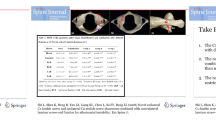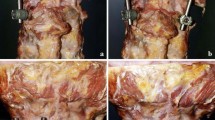Abstract
Background
Posterior atlantoaxial fixation with screw rod forms an approximate “II” shape or “H” increasing transverse link for better stability. In order to improve stability and in consideration of difficult placement of transverse connecting rod, possibility of inadequate bone graft, some scholars have preliminarily researched biomechanics of a novel crossed rod as an approximate “X” configuration of screw rod.
Purpose
The aim of this study was to evaluate and compare the biomechanics of the crossed and parallel rod configurations in the screw rod system for posterior atlantoaxial fixation on a cadaveric model.
Methods
Six fresh cervical specimens were used to complete the range of motion (ROM) testing by applying pure moments of ± 2.0 nm. Following intact state and under destabilization testing, screws were implanted. The specimens were then tested in the following sequence: Group BLS + PR (C2 bilateral laminar screws + parallel rod), Group BLS + CR (C2 bilateral laminar screws + crossed rod), LPRLS + PR (C2 left pedicle screw and right laminar screw + parallel rod), LPRLS + CR (C2 left pedicle screw and right laminar screw + crossed rod), BPS + PR (C2 bilateral pedicle screws + parallel rod) and BPS + CR (C2 bilateral pedicle screws + crossed rod). The ROM of the C1–2 segments was measured in flexion–extension, lateral bending and axial rotation. Six surgical constructs were compared between the groups and with intact condition, respectively.
Results
The six fixed modes significantly increased stability compared with both the intact and destabilization group in flexion–extension, lateral bending and axial rotation (p < .05). In extension, BPS + CR and BLS + CR showed greater stability than BLS + PR (p < .05). During flexion, the six fixation methods showed no statistical significance (p > .05). In left lateral bending, stability of the other five screw rod fixation techniques significantly increased when compared with BLS + PR (p < .05). In the right lateral bending direction, the stability of BLS + PR was worse than that of BPS + CR and BPS + PR (p < .05). In the left axial rotation, stability of BLS + CR, LPRLS + CR and BPS + CR was greater than that of BLS + PR, LPRLS + PR and BPS + PR (p < .05). In the right axial rotation, the stability of BPS + CR and BLS + CR was greater than that of BLS + PR (p < .05).
Conclusion
The six investigated fixation methods provide sufficient biomechanical stability. The crossed rod configuration can further enhance the axial rotation stability of the screw rod system, which consists of C1 bilateral pedicle and C2 pedicle, or C2 lamina screws. The crossed rod can also improve the stability of the screw rod system made up of C1 bilateral pedicle and C2 lamina screws in lateral bending and extension. The crossed rod configuration is reliable and provides superior stability for clinical application.






Similar content being viewed by others
References
Shao J, Gao YZ, Gao K et al (2019) Posterior screw-rod fixation and selective axial loosening for the treatment of atlantoaxial instability or dislocation caused by Os Odontoideum: a case series for a single posterior approach. World Neurosurg 132:e193–e201. https://doi.org/10.1016/j.wneu.2019.08.208
Shi L, Shen K, Deng R et al (2019) Novel unilateral C1 double screw and ipsilateral C2 pedicle screw placement combined with contralateral laminar screw-rod fixation for atlantoaxial instability. Eur Spine J 28(2):362–369. https://doi.org/10.1007/s00586-018-5853-0
Lapsiwala SB, Anderson PA, Oza A et al (2006) Biomechanical comparison of four C1 to C2 rigid fixative techniques: anterior transarticular, posterior transarticular, C1 to C2 pedicle, and C1 to C2 intralaminar screws. Neurosurgery 58(3):516–521. https://doi.org/10.1227/01.NEU.0000197222.05299.31
Sim H B, Lee J W, Park J T et al (2011) Biomechanical evaluations of various c1-c2 posterior fixation techniques. Spine (Phila Pa 1976), 36(6): E401-E407 https://doi.org/10.1097/BRS.0b013e31820611ba.
Lehman RJ, Dmitriev AE, Wilson KW (2012) Biomechanical analysis of the C2 intralaminar fixation technique using a cross-link and offset connector for an unstable atlantoaxial joint. Spine J 12(2):151–156. https://doi.org/10.1016/j.spinee.2012.01.020
Gabriel JP, Muzumdar AM, Khalil S et al (2011) A novel crossed rod configuration incorporating translaminar screws for occipitocervical internal fixation: an in vitro biomechanical study. Spine J 11(1):30–35. https://doi.org/10.1016/j.spinee.2010.09.013
Shen K, Deng Z, Yang J et al (2017) Biomechanical study of novel unilateral C1 posterior arch screws and C2 laminar screws combined with an ipsilateral crossed C1–C2 pedicle screw-rod fixation for atlantoaxial instability. Arch Orthop Trauma Surg 137(10):1349–1355. https://doi.org/10.1007/s00402-017-2781-0
Chen J, Zhou F, Ni B et al (2016) New Posterior Atlantoaxial Restricted Non-Fusion Fixation for Atlantoaxial Instability: A Biomechanical Study. Neurosurgery 78(5):735–741. https://doi.org/10.1227/NEU.0000000000001122
Liu S, Song Z, Liu L et al (2018) Biomechanical evaluation of C1 lateral mass and C2 translaminar bicortical screws in atlantoaxial fixation: an in vitro human cadaveric study. Spine J 18(4):674–681. https://doi.org/10.1016/j.spinee.2017.12.011
Wilke HJ, Wenger K, Claes L (1998) Testing criteria for spinal implants: recommendations for the standardization of in vitro stability testing of spinal implants. Eur Spine J 7(2):148–154. https://doi.org/10.1007/s005860050045
Chun DH, Yoon DH, Kim KN et al (2018) Biomechanical Comparison of Four Different Atlantoaxial Posterior Fixation Constructs in Adults: A Finite Element Study. Spine (Phila Pa 1976) 43(15): E891-E897 https://doi.org/10.1097/BRS.0000000000002584.
Du JY, Aichmair A, Kueper J et al (2015) Biomechanical analysis of screw constructs for atlantoaxial fixation in cadavers: a systematic review and meta-analysis. J Neurosurg Spine 22(2):151–161. https://doi.org/10.3171/2014.10.SPINE13805
Huang DG, Wang T, Hao DJ et al (2017) Posterior C1–C2 screw-rod fixation and autograft fusion for the treatment of os odontoideum with C1–C2 instability. Clin Neurol Neurosurg 163:71–75. https://doi.org/10.1016/j.clineuro.2017.10.016
Guo SL, Zhou DB, Yu XG et al (2014) Posterior C1–C2 screw and rod instrument for reduction and fixation of basilar invagination with atlantoaxial dislocation. Eur Spine J 23(8):1666–1672. https://doi.org/10.1007/s00586-014-3409-5
Fensky F, Kueny RA, Sellenschloh K et al (2014) Biomechanical advantage of C1 pedicle screws over C1 lateral mass screws: a cadaveric study. Eur Spine J 23(4):724–731. https://doi.org/10.1007/s00586-013-3143-4
Su BW, Shimer AL, Chinthakunta S et al (2014) Comparison of fatigue strength of C2 pedicle screws, C2 pars screws, and a hybrid construct in C1-C2 fixation. Spine (Phila Pa 1976), 39(1):E12–9 https://doi.org/10.1097/BRS.0000000000000063
Dmitriev AE, Lehman RA Jr, Helgeson MD et al (2009) Acute and long-term stability of atlantoaxial fixation methods: a biomechanical comparison of pars, pedicle, and intralaminar fixation in an intact and odontoid fracture model. Spine 34(4):365–370. https://doi.org/10.1097/BRS.0b013e3181976aa9
Singh B, Cree A (2015) Laminar screw fixation of the axis in the pediatric population: a series of eight patients. Spine J 15(2):e17-25. https://doi.org/10.1016/j.spinee.2014.10.009
Marco RAW, Phelps CI, Kuo RC et al (2018) Radiologic analysis of C2 to predict safe placement of pedicle screws. Int J Spine Surg 12(1):30–36. https://doi.org/10.14444/5006
Park JS, Cho DC, Sung JK (2012) Feasibility of C2 translaminar screw as an alternative or salvage of C2 pedicle screws in atlantoaxial instability. J Spinal Disord Tech 25(5):254–258. https://doi.org/10.1097/BSD.0b013e318218a4f7
Salzmann SN, Okano I, Ortiz Miller C et al (2020) Regional bone mineral density differences measured by quantitative computed tomography in patients undergoing anterior cervical spine surgery. Spine J 20(7):1056–1064. https://doi.org/10.1016/j.spinee.2020.02.011
Acknowledgments
Funding was received in support of this work from the Science and technology project of Guangdong Province (grant number 201803010046) and Science and technology project of Guangdong Province (grant number 2015B020233013).
Author information
Authors and Affiliations
Corresponding author
Ethics declarations
Conflict of interest
All authors declare that they have no conflict of interest.
Additional information
Publisher's Note
Springer Nature remains neutral with regard to jurisdictional claims in published maps and institutional affiliations.
Rights and permissions
About this article
Cite this article
Qiu, F., Zou, XB., Xu, XL. et al. A biomechanical comparison of crossed and parallel rod configurations in atlantoaxial internal fixation. Eur Spine J 30, 576–584 (2021). https://doi.org/10.1007/s00586-020-06655-6
Received:
Revised:
Accepted:
Published:
Issue Date:
DOI: https://doi.org/10.1007/s00586-020-06655-6




